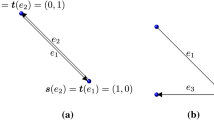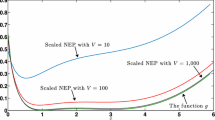Abstract
The dynamics exhibited by reaction networks is often a manifestation of their steady states. We show that there exists endotactic and strongly endotactic dynamical systems that are not weakly reversible and possess a family of infinitely many positive steady states. In addition, we prove for some of these systems that there exist no weakly reversible mass-action systems that are dynamically equivalent to mass-action systems generated by these networks. This extends a result by Boros, Craciun and Yu [1], who proved the existence of weakly reversible dynamical systems with infinitely many steady states.
























Similar content being viewed by others
References
B. Boros, G. Craciun, P. Yu, Weakly reversible mass-action systems with infinitely many positive steady states. SIAM J. Appl. Math. 80(4), 1936–1946 (2020)
G. Craciun, F. Nazarov, C. Pantea, Persistence and permanence of mass-action and power-law dynamical systems. SIAM J. Appl. Math. 73(1), 305–329 (2013)
M. Gopalkrishnan, E. Miller, A. Shiu, A geometric approach to the global attractor conjecture. SIAM J. Appl. Dyn. Syst. 13(2), 758–797 (2014)
Craciun, G.: Toric differential inclusions and a proof of the global attractor conjecture. arXiv preprint arXiv:1501.02860 (2015)
D. Bates, P. Breiding, T. Chen, J. Hauenstein, A. Leykin, F. Sottile, Numerical nonlinear algebra, arXiv preprint arXiv:2302.08585 (2023)
P. Breiding, S. Timme, Homotopycontinuation. jl: A package for homotopy continuation in julia, Mathematical Software-ICMS, 6th International Conference, South Bend, IN, USA, July 24–27, 2018, Proceedings 6. Springer 2018, 458–465 (2018)
J. Collins, J. Hauenstein, A singular value homotopy for finding critical parameter values. Appl. Numer. Math. 161, 233–243 (2021)
J. Deng, C. Jones, M. Feinberg, A. Nachman, On the steady states of weakly reversible chemical reaction networks, arXiv preprint arXiv:1111.2386 (2011)
B. Boros, Existence of positive steady states for weakly reversible mass-action systems. SIAM J. Math. Anal. 51(1), 435–449 (2019)
E. Feliu, O. Henriksson, B. Pascual-Escudero, Dimension and degeneracy of solutions of parametric polynomial systems arising from reaction networks, arXiv preprint arXiv:2304.02302 (2023)
F. Horn, R. Jackson, General mass action kinetics. Arch. Ration. Mech. Anal. 47(2), 81–116 (1972)
F. Horn, Necessary and sufficient conditions for complex balancing in chemical kinetics. Arch. Ration. Mech. Anal. 49(3), 172–186 (1972)
M. Feinberg, Lectures on chemical reaction networks (University of Wisconsin, Notes of lectures given at the Mathematics Research Center, 1979), p.49
P. Mezey, From reaction path to reaction mechanism: Fundamental groups and symmetry rules, The reaction path in chemistry: current approaches and perspectives, Springer, (1995), pp. 11–38
P. Mezey, The topology of energy hypersurfaces v. potential-defying chemical species: a global analysis of vibrational stabilization and destabilization on potential energy hypersurfaces. Theor. Chim. Acta 67, 115–136 (1985)
P. Mezey, Quantum chemical reaction networks, reaction graphs and the structure of potential energy hypersurfaces. Theor. Chim. Acta 60, 409–428 (1982)
P. Mezey, Reaction topology of excited state potential energy hypersurfaces. Can. J. Chem. 61(5), 956–961 (1983)
P. Mezey, Potential energy hypersurfaces (1987)
A. von Lilienfeld, K. Müller, A. Tkatchenko, Exploring chemical compound space with quantum-based machine learning. Nat. Rev. Chem. 4(7), 347–358 (2020)
M. Bragato, G. von Rudorff, A. von Lilienfeld, Data enhanced Hammett-equation: reaction barriers in chemical space. Chem. Sci. 11(43), 11859–11868 (2020)
K. Chang, S. Fias, R. Ramakrishnan, O.A. Von Lilienfeld, Fast and accurate predictions of covalent bonds in chemical space. J. Chem. Phys. 144(17), 174 (2016)
G. Craciun, Polynomial dynamical systems, reaction networks, and toric differential inclusions. SIAM J. Appl. Algebra Geom. 3(1), 87–106 (2019)
G. Craciun, A. Deshpande, Endotactic networks and toric differential inclusions. SIAM J. Appl. Dyn. Syst. 19(3), 1798–1822 (2020)
C. Craciun, A. Deshpande, J. Yeon, Quasi-toric differential inclusions. Discrete Contin. Dyn. Syst. B 26(5), 2343–2359 (2021)
J. Gunawardena, Chemical reaction network theory for in-silico biologists, Notes available for download at http://vcp. med. harvard. edu/papers/crnt. pdf (2003)
D. Anderson, J. Brunner, G. Craciun, M. Johnston, On classes of reaction networks and their associated polynomial dynamical systems. J. Math. Chem. 58(9), 1895–1925 (2020)
C. Guldberg, P. Waage, Studies concerning affinity. CM Forhandlinger: Videnskabs-Selskabet I Christiana 35(1864), 1864 (1864)
M. Feinberg, Chemical reaction network structure and the stability of complex isothermal reactors—I. the deficiency zero and deficiency one theorems. Chem. Eng. Sci. 42(10), 2229–2268 (1987)
P. Yu, G. Craciun, Mathematical analysis of chemical reaction systems. Isr. J. Chem. 58(6–7), 733–741 (2018)
L. Adleman, M. Gopalkrishnan, M. Huang, P. Moisset, D. Reishus, On the mathematics of the law of mass action, A Systems Theoretic Approach to Systems and Synthetic Biology I: Models and System Characterizations, Springer, 2014, pp. 3–46
D. Angeli, P. De Leenheer, E. Sontag, A petri net approach to persistence analysis in chemical reaction networks (Current Challenges, Biology and Control Theory, 2007), pp.181–216
M. Ali Al-Radhawi, D. Angeli, E. Sontag, A computational framework for a lyapunov-enabled analysis of biochemical reaction networks. PLoS Comput. Biol. 16(2), e1007681 (2020)
D. Angeli, P. De Leenheer, E. Sontag, A petri net approach to the study of persistence in chemical reaction networks. Math. Biosci. 210(2), 598–618 (2007)
M. Marcondes de Freitas, E. Feliu, C. Wiuf, Intermediates, catalysts, persistence, and boundary steady states. J. Math. Biol. 74, 887–932 (2017)
A. Deshpande, M. Gopalkrishnan, Autocatalysis in reaction networks. Bull. Math. Biol. 76(10), 2570–2595 (2014)
C. Pantea, On the persistence and global stability of mass-action systems. SIAM J. Math. Anal. 44(3), 1636–1673 (2012)
D. Anderson, A proof of the global attractor conjecture in the single linkage class case. SIAM J. Appl. Math. 71(4), 1487–1508 (2011)
Y. Ding, A. Deshpande, G. Craciun, Minimal invariant regions and minimal globally attracting regions for variable-k reaction systems. Discrete Contin. Dyn. Syst. Ser. B 28(3), 696–1718 (2023)
Y. Ding, A. Deshpande, G. Craciun, Minimal invariant regions and minimal globally attracting regions for toric differential inclusions. Adv. Appl. Math. 136, 102307 (2022)
G. Craciun, C. Pantea, Identifiability of chemical reaction networks. J. Math. Chem. 44(1), 244–259 (2008)
G. Craciun, J. Jin, P. Yu, An efficient characterization of complex-balanced, detailed-balanced, and weakly reversible systems. SIAM J. Appl. Math. 80(1), 183–205 (2020)
A. Deshpande, Source-only realizations, weakly reversible deficiency one networks, and dynamical equivalence. SIAM J. Appl. Dyn. Syst. 22(2), 1502–1521 (2023)
G. Craciun, A. Deshpande, J. Jin, Weakly reversible single linkage class realizations of polynomial dynamical systems: an algorithmic perspective. Discrete Contin. Dyn. Syst. Ser. B 62, 476–501 (2023)
G. Craciun, A. Deshpande, J. Jin, Weakly reversible single linkage class realizations of polynomial dynamical systems: an algorithmic perspective. J. Math. Chem. 62(2), 476–501 (2023)
B. Sturmfels, Grobner Bases and Convex Polytopes, vol. 8 (American Mathematical Society, Providence, 1996)
G. Craciun, A. Deshpande, J. Jin, Weakly reversible single linkage class realizations of polynomial dynamical systems: an algorithmic perspective. J. Math. Chem. 62(2), 476–501 (2024)
P. Donnell, M. Banaji, A. Marginean, C. Pantea, CoNtRol: an open source framework for the analysis of chemical reaction networks. Bioinformatics 30(11), 1633–1634 (2014)
Funding
AD would like to acknowledge support from SERB Start-up Research Grant SRG/2022/001404.
Author information
Authors and Affiliations
Corresponding author
Ethics declarations
Conflict of interest
The authors have no Conflict of interest to declare which are relevant to the content of this article.
Ethical approval
This material is the authors’ own original work and has not been previously published elsewhere.
Data availability
No datasets were created during the preparation of the manuscript.
Additional information
Publisher's Note
Springer Nature remains neutral with regard to jurisdictional claims in published maps and institutional affiliations.
Rights and permissions
Springer Nature or its licensor (e.g. a society or other partner) holds exclusive rights to this article under a publishing agreement with the author(s) or other rightsholder(s); author self-archiving of the accepted manuscript version of this article is solely governed by the terms of such publishing agreement and applicable law.
About this article
Cite this article
Kothari, S., Deshpande, A. Endotactic and strongly endotactic networks with infinitely many positive steady states. J Math Chem (2024). https://doi.org/10.1007/s10910-024-01617-5
Received:
Accepted:
Published:
DOI: https://doi.org/10.1007/s10910-024-01617-5




